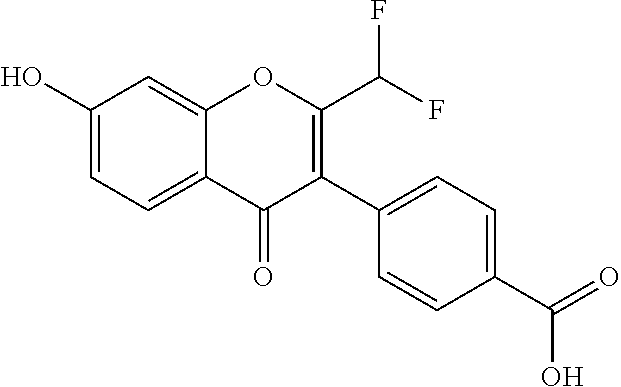Chromone inhibitors of S-nitrosoglutathione reductase
- Summary
- Abstract
- Description
- Claims
- Application Information
AI Technical Summary
Benefits of technology
Problems solved by technology
Method used
Image
Examples
example 1
4-(2-(difluoromethyl)-7-hydroxy-4-oxo-4H-chromen-3-yl)benzoic acid
[0122]
[0123]Synthesis: Prepared following General Scheme 1, starting from Intermediate A-1a, using conditions a) (modified) and c).
[0124]Step 1: Synthesis of ethyl 4-(2-(difluoromethyl)-7-hydroxy-4-oxo-4H-chromen-3-yl)benzoate: To a solution of Intermediate A-1a (450 mg, 1.5 mmol) and TEA (758 mg, 7.5 mmol) was added 2,2-difluoroacetic anhydride (522 mg, 3.0 mmol). The mixture was stirred at 120° C. for 4 h. The reaction mixture was cooled to room temperature and concentrated in vacuo to afford a brown solid, which was used for next step without further purification (400 mg, 74%).
[0125]Step 2: Synthesis of 4-(2-(difluoromethyl)-7-hydroxy-4-oxo-4H-chromen-3-yl)benzoic acid (Example 1), an example of c) conditions: To a mixture of ethyl 4-(2-(difluoromethyl)-7-hydroxy-4-oxo-4H-chromen-3-yl)benzoate (400 mg, 1.16 mmol) in 1,4-dioxane (1 mL) was added Conc. HCl (1 mL). The reaction mixture was heated to reflux overnight. ...
example 2
4-(7-hydroxy-2-(methoxymethyl)-4-oxo-4H-chromen-3-yl)benzoic acid
[0127]
[0128]Synthesis: Prepared following General Scheme 1, starting from Intermediate A-1a, using conditions b) (modified) and c).
[0129]Step 1: Synthesis of ethyl 4-(7-hydroxy-2-(methoxymethyl)-4-oxo-4H-chromen-3-yl)benzoate, an example of b) conditions. To stirred mixture of Intermediate A-1a (450 mg, 1.5 mmol) and Et3N (825 mg, 7.5 mmol) in DCM (5 mL) was added 2-methoxyacetyl chloride (486 mg, 4.5 mmol). Then the mixture was stirred at room temperature for 5 h. The solution was removed under reduced pressure and the residue was diluted with water (50 mL), extracted with ethyl acetate (50 mL×3). The organic layers were dried over Na2SO4, concentrated and purified by silica gel column chromatography (PE:EA=1:1) to afford ethyl 4-(7-hydroxy-2-(methoxymethyl)-4-oxo-4H-chromen-3-yl)benzoate as a yellow oil (84 mg, 16%). MS (ESI): m / z 355.0 [M+1]+.
[0130]Step 2: Synthesis of 4-(7-hydroxy-2-(methoxymethyl)-4-oxo-4H-chromen...
example 3
4-(7-hydroxy-2-isopropyl-4-oxo-4H-chromen-3-yl)benzoic acid
[0132]
[0133]Synthesis: Prepared following General Scheme 1, starting from Intermediate A-1a, using conditions b) and d). Synthetic details included here as an example of b) and d).
[0134]Step 1: Synthesis of ethyl 4-(7-(isobutyryloxy)-2-isopropyl-4-oxo-4H-chromen-3-yl)benzoate, an Example of Scheme 1, b) conditions.
[0135]To a solution of Intermediate A-1a (450 mg, crude, 1.5 mmol) and TEA (834μL, 6 mmol) in dried DCM (5 mL) was added dropwise isobutyryl chloride (480 μL, 4.5 mmol) at room temperature. The mixture was stirred for 3 h. The volatiles were removed under reduced pressure. To the residue was added TEA (5 mL) and heated at 95 ° C. overnight. Cooled to room temperature and filtered; the filter cake was washed with EA (10 mL). The filtrate was concentrated and purified by Combi-Flash (40 g silica gel, start PE:EA=10:0 to 3:1 gradient, 40 mL / min, 40 min, 1.6 L total solvent volume) to afford ethyl 4-(7-(isobutyryloxy)-...
PUM
| Property | Measurement | Unit |
|---|---|---|
| half life | aaaaa | aaaaa |
| temperature | aaaaa | aaaaa |
| temperature | aaaaa | aaaaa |
Abstract
Description
Claims
Application Information
 Login to View More
Login to View More - R&D
- Intellectual Property
- Life Sciences
- Materials
- Tech Scout
- Unparalleled Data Quality
- Higher Quality Content
- 60% Fewer Hallucinations
Browse by: Latest US Patents, China's latest patents, Technical Efficacy Thesaurus, Application Domain, Technology Topic, Popular Technical Reports.
© 2025 PatSnap. All rights reserved.Legal|Privacy policy|Modern Slavery Act Transparency Statement|Sitemap|About US| Contact US: help@patsnap.com



